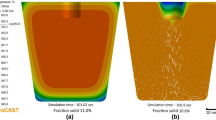Abstract
Ultrasonic treatment (UST) was studied in this work to improve the quality of the cast ingots as well as to control the solidification structure evolution. Ultrasonically induced cavitation consists of the formation of small cavities (bubbles) in the molten metal followed by their growth, pulsation, and collapse. These cavities are created by the tensile stresses that are produced by acoustic waves in the rarefaction phase. The pressure for nucleation of the bubbles (e.g., cavitation threshold pressure) may decrease with increasing the amount of dissolved gases and especially with the amount of inclusions in the melt. Modeling and simulation of casting solidification of alloys with UST requires complex multiscale computations, from computational fluid dynamics (CFD) macroscopic modeling through mesoscopic to microscopic modeling, as well as strategies to link various length-scales emerged in modeling of microstructural evolution. The developed UST modeling approach is based on the numerical solution of the Lilley model (that is founded on Lighthills’s acoustic analogy), fluid flow, heat transfer equations, and mesoscopic modeling of the grain structure. The CFD analysis tool is capable of modeling acoustic streaming and ultrasonic cavitation. It is used in this work to study ingot solidification under the presence of ultrasound. The UST model was applied to low-temperature alloys including Al- and Mg-based alloys. Although the predicted ultrasonic cavitation region is relatively small, the acoustic streaming is strong and, thus, the created/survived bubbles/nuclei are transported into the bulk liquid quickly. The predicted grain size under UST condition is at least one order of magnitude lower than that without UST.











Similar content being viewed by others
References
O.V. Abramov: High-Intensity Ultrasonics: Theory and Industrial Applications, Gordon and Breach Science Publishers, New York, NY, 1998.
G.I. Eskin: Ultrasonic Treatment of Light Alloy Melts, Gordon and Breach Science Publishers, New York, NY, 1998.
L.D. Rosenberg, ed.: Sources of High-Intensity Ultrasound, Plenum Press, New York, NY, vols. 1–2, 1969.
J. Campbell: Int. Met. Rev., 1981, vol. 26, pp. 71-108.
X. Jian, T.T. Meek, and Q. Han: Scripta Mater., 2006, vol. 54, pp. 893-96.
X. Jian, H. Xu, T.T. Meek, and Q. Han: Mater. Lett, 2005, vol. 59, pp. 190-93.
T.T. Meek and Q. Han: Ultrasonic Processing of Materials, Final DOE Technical Report, Oak Ridge National Laboratory, 2006.
Fluent 6.3 User’s Guide Manual (Fluent Inc., 2006).
C.E. Brennen: Cavitation and Bubble Dynamics, Oxford University Press, New York, 1995, p. 51.
N.H. El Kaddah and D.G.C. Robertson: J. Coloids Interface Sci., 1977, vol. 60, no. 2, pp. 349-60.
A.D. Pierce: Acoustics: An Introduction to its Physical Principles and Applications, McGraw-Hill, Columbus, OH, 1981.
B.E. Noltingk and E.A. Neppiras: Proc. Phys. Soc., 1951, vol. 64B, p. 1032.
J. Rayleigh: Phil. Mag., 1917, vol. 34, p. 94.
L. Nastac: Modeling and Simulation of Microstructure Evolution in Solidifying Alloys, Springer, New York, NY, 2004.
L. Nastac: Acta Metall., 1999, vol. 47, no. 17, pp. 4253-62.
X. Li: Research Progress on Ultrasonic Cavitation Based Dispersion of Nanoparticles in Al/Mg Melts for Solidification Processing of Bulk Lightweight Metal Matrix Nanocomposites, TMS, Annual Meeting, Orlando, FL, 2007.
L. Nastac and Y. Dai: Ultrasonic Model Development and Applications to Ingot Casting Processes, 2008 International Ansys Conference, Pittsburgh, PA, 2008.
Acknowledgment
The author would like to acknowledge Dr. Nagy El Kaddah and Dr. Layachi Hadji from the University of Alabama, MTE Department, for their useful comments and suggestions on this UST study.
Author information
Authors and Affiliations
Corresponding author
Additional information
Manuscript submitted May 19, 2011.
Appendix: Approach for Modeling of Ultrasonic Vibration in Fluids
Appendix: Approach for Modeling of Ultrasonic Vibration in Fluids
For planar propagation in x-direction, the ultrasonic pressure, p us (in Pa), is given by:
The ultrasonic intensity, I us (in W/m2), can be calculated with:
In Eqs. [A1] and [A2], ρ is the material density, ω is the angular frequency, k is a coefficient of proportionality, η is the material dynamic viscosity, I o us is the reference ultrasonic intensity at x = 0, f is the sound frequency, v is the velocity, a is the amplitude of the oscillations, α is the absorption coefficient, t is time, C is a material constant, and x is the distance. For example, α for metals at f = 20 kHz is of the order of 10−6 [m−1].
The fluid flow with ultrasonic vibration can be described by the continuity (mass conservation) and Navier–Stokes momentum equations, where the additional source term is the volumetric force, F us , that is calculated as:
Heat transfer is described by the energy equation where the additional source term is the rate of ultrasonic heating, Q us :
Rights and permissions
About this article
Cite this article
Nastac, L. Mathematical Modeling of the Solidification Structure Evolution in the Presence of Ultrasonic Stirring. Metall Mater Trans B 42, 1297–1305 (2011). https://doi.org/10.1007/s11663-011-9539-9
Published:
Issue Date:
DOI: https://doi.org/10.1007/s11663-011-9539-9



